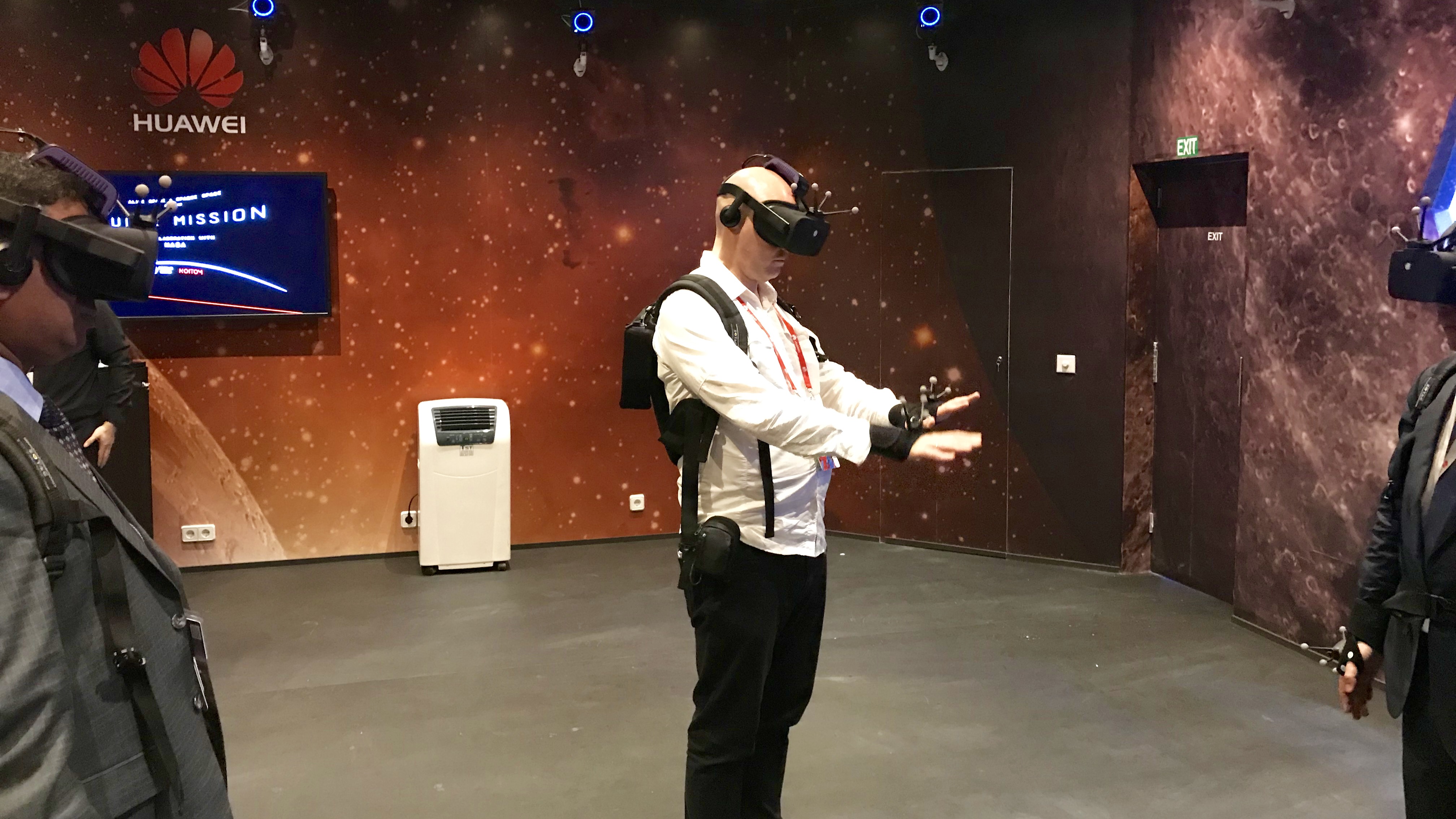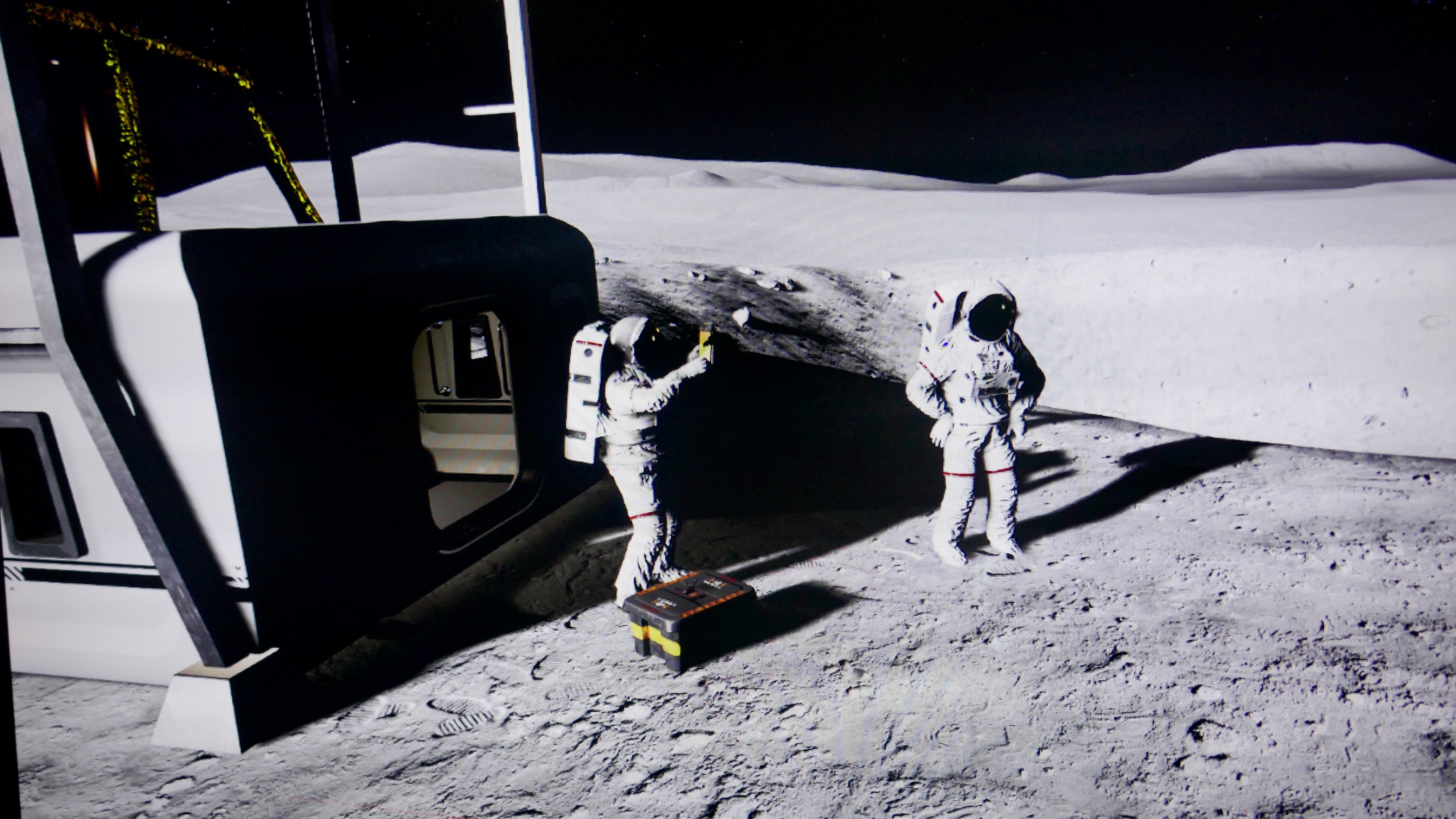Project Alice lets you walk on the moon in a motion-tracked VR headset
Oculus Rift takes you to the moon

A human has not walked on the moon for almost 45 years, and that’s not going to change anytime soon. So why not take a virtual trip? Designed by Beijing-based virtual reality (VR) tech company Noitom in conjunction with Huawei and TPCast, the Project Alice demo at the Mobile World Congress this year is as close as it’s possible to get to walking on the lunar surface.
Found at the back of the GSMA Innovation City, Earthlight: Lunar Mission goes way beyond the Oculus Rift headsets it uses. Project Alice is more about mixed reality than simple VR; it allows multiple players (in this case, a crew of three astronauts), and uses motion capture, physical props tracked in 3D, and a large tracking space up to 23ft x 33ft / 7m x 10m.

The external tracking system used is way beyond what you could achieve at home with just a VR headset; this is ultra-accurate multi-player VR.
A total of 16 OptiTrack precision-tracking cameras are ranged about 10 ft off the ground around the room. Everything, from the hands of the astronauts to the objects they can pick-up during the game, are covered in small white reflective balls that work as optical trackers.
“The cameras respond to them, but this is a hybrid tracking system because we also use IMU sensors,” says Lu Miao at Noitum. Inertial Measurement Units (IMU) deal in depth and motion-sensing only, and are found in the Oculus Rift and also in the hand-trackers, but on their own they’re only capable of calculating the relative position of the wearer. “IMUs only provide rotational data, it’s not an absolute position – it’s the cameras that add the absolute position.”
Because it’s done at the speed of light, it means players can interact with each other. “It’s also really low latency – just 2.5 milliseconds – so you can interact with the other astronauts,” says Miao.

"In the old build was each player wearing a backpack PC to render everything, but Huawei has given us a data transmission so the new build is just a receiver on the headset and a battery," says Ray Millares, Project Alice Product Specialist, Noitom. "All the rendering and the computing is done on the cloud and, using 5G, it's transmitted to whatever location. As 5G advances you could use this for off-site training – all you would need would be a headset and a receiver." However, each player wears a small fabric backpack just to replicate what real astronauts experience.
Sign up for breaking news, reviews, opinion, top tech deals, and more.
Take me to the moon
Using Oculus Rift headsets equipped with TPCast wireless adaptors, Earthlight: Lunar Mission lasts about five minutes. You and two other astronauts begin in a lunar lander, can interact with each other (cue high-fives), step out into a holding area and view the moon as you come into land, then walk out onto the moon itself. As usual in small and large-scale VR experiences, there’s a red line on the floor that you can’t cross (and you wouldn’t want to – a wall awaits), but beyond is a fabulously futuristic moonbase to gawp at.
It may not be real, but it is possible to leave footprints on the lunar surface. However, players can’t actually see their feet. An algorithm works out where they would be judging on the position of the player’s hands and head, though the footprints are something you can only look back at.

Earthlight: Lunar Mission has been developed exclusively for Noitom’s Project Alice by Melbourne, Australia-based VR developer Opaque Space, which is currently working with Boeing on a VR trainer for its International Space Station-bound CST-100 Starliner. If that has close ties to NASA, so does Opaque Space, which has tried to make this special edition of Earthlight: Lunar Mission’for Noitom as true-to-life as possible.
With the help of NASA’s OpsLab, that even goes down to geographically accurate lunar terrain, and a claustrophobic feel created by having a restricted view of the astronaut’s helmet. Not being able to look at your feet, or see much in the corners of your field of view is slightly annoying while you’re immersed in the game, but that’s what it’s like to be an astronaut. "NASA was adamant that we leave that in," says Millares.

NASA’s touches elsewhere are apparent, particularly in the moon’s night sky, which features a super-bright Milky Way. Pick up the tablet from the lunar surface (it’s actually a polystyrene block) and the screen will give you the name of the constellation you’re holding it in front of, just like a planetarium app. “You could also use this for education, getting children to walk through the solar system and pick-up and place the planets in the correct order,” says Miao.
As for the objects that can be picked-up, anything’s possible. “We can put anything in there – you just get the object, such as a real chair, and make a 3D model of it,” says Miao. The tablet used to stargaze turns out to be a block of polystyrene, and that trunk for collecting Moon-rock? “Actually that’s from IKEA!” exclaims Miao.
For Noitom, Earthlight: Lunar Mission is but the first of five experiences planned for staggered release over the next two years. Confirmed titles include Destination: Mars and the intriguing Europa’s Ice World. And the price? A paltry US$199,000 for the hardware rig and US$6,000 per month for the software. It’s still much cheaper than a SpaceX Falcon 9 launch, which costs around US$57 million, but hey, walking on the moon doesn’t have to be rocket science.
MWC (Mobile World Congress) is the world's largest exhibition for the mobile industry, stuffed full of the newest phones, tablets, wearables and more. TechRadar is reporting live from Barcelona all week to bring you the very latest from the show floor. Head to our dedicated MWC 2018 hub to see all the new releases, along with TechRadar's world-class analysis and buying advice about your next phone.
- Console-powered VR: the PlayStation VR tops the charts

Jamie is a freelance tech, travel and space journalist based in the UK. He’s been writing regularly for Techradar since it was launched in 2008 and also writes regularly for Forbes, The Telegraph, the South China Morning Post, Sky & Telescope and the Sky At Night magazine as well as other Future titles T3, Digital Camera World, All About Space and Space.com. He also edits two of his own websites, TravGear.com and WhenIsTheNextEclipse.com that reflect his obsession with travel gear and solar eclipse travel. He is the author of A Stargazing Program For Beginners (Springer, 2015),